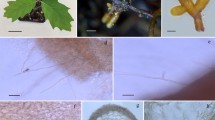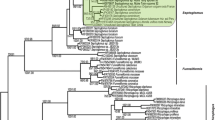Abstract
Tuber melanosporum is widely cultivated outside its natural habitat in various climatic conditions. This study aims to monitor the persistence of T. melanosporum in inoculated oak seedlings and document temporal changes of native ectomycorrhizal fungi in an Estonian 5-year-old plantation. Sampling of ectomycorrhizal fungi was carried out in June–July 2011–2013 to provide DNA-based identification of the inoculated truffle species and other co-occurring ectomycorrhizal fungi. The mycorrhiza of T. melanosporum proved resistant to cold winters, and the fungus persisted well in the root systems of surviving seedlings albeit slight decline in relative colonization level over 3 years. We identified the genera Hymenogaster and Hebeloma to be the dominant ectomycorrhizal competing fungi in root systems. Good vegetative growth of mycelia and the presence of two compatible mating types suggest that cultivation of T. melanosporum is possible in the Nordic climate. Evaluation of fruit-body production will be a critical next step, because fruiting efficiency allows to determine economic feasibility and ecological sustainability of the Périgord truffle cultivation in northern climate.



Similar content being viewed by others
References
Abarenkov K, Tedersoo L, Nilsson RH, Vellak K, Saar I, Veldre V, Parmasto E, Prous M, Aan A, Ots M, Kurina O, Ostonen I, Jõgeva J, Halapuu S, Põldmaa K, Toots M, Truu J, Larsson KH, Kõljalg U (2010) PlutoF—a web based workbench for ecological and taxonomic research with an online implementation for fungal ITS sequences. Evol Bioinforma 6:189–196
Anderson MJ, Gorley RN, Clarke KR (2008) PERMANOVA + for PRIMER: guide to software and statistical methods. PRIMER-E, Plymouth
Baciarelli-Falini L, Rubini A, Riccioni C, Paolocci F (2006) Morphological and molecular analyses of ectomycorrhizal diversity in a man-made T. melanosporum plantation: description of novel truffle-like morphotypes. Mycorrhiza 16:475–484
Belfiori B, Riccioni C, Tempesta S, Pasqualetti M, Paolocci F, Rubini A (2012) Comparison of ectomycorrhizal communities in natural and cultivated Tuber melanosporum truffle grounds. FEMS Microbiol Ecol 81:547–561
Bruhn J, Hall M (2011) Burgundy black truffle cultivation in an agroforestry practice. University of Missouri Center for Agroforestry. Agrofor in action. AF1015
Butler G (2007) The evolution of MAT: the ascomycetes. In: Heitman J, Kronstad JW, Taylor JW, Casselton L (eds) Sex in fungi: molecular determination and evolutionary implications. ASM, Washington, pp 3–18
Colwell RK (2011) EstimateS: statistical estimation of species richness and shared species from samples. Version 9. User’s guide and application published at http://purl.oclc.org/estimates (18 February 2014, date last accessed)
de Miguel AM, Águeda B, Sánchez S, Parladé J (2014) Ectomycorrhizal fungus diversity and community structure with natural and cultivated truffle hosts: applying lessons learned to future truffle culture. Mycorrhiza. doi:10.1007/s00572-013-0554-3
Garcia-Barreda S, Reyna S (2011) Below-ground ectomycorrhizal community in natural Tuber melanosporum truffle grounds and dynamics after canopy opening. Mycorrhiza. doi:10.1007/s00572-011-0410-2
Hall I, Yun W (2001) Truffles and other edible mycorrhizal mushrooms—some new crops for the Southern Hemisphere. In: Proceedings of the Second International Conference on Edible Mycorrhizal Mushrooms. New Zealand Institute for Crop & Food Research Limited, Christchurch, New Zealand, pp 1–7
Mello A, Murat C, Bonfante P (2006) Truffles: much more than a prized and local fungal delicacy. FEMS Microbiol Lett 260:1–8
Murat C, Martin F (2008) Sex and truffles: first evidence of Perigord black truffle outcrosses. New Phytol 180:260–263
Murat C, Díez J, Luis P, Delaruelle C, Dupré C, Chevalier G, Bonfante B, Martin F (2004) Polymorphism at the ribosomal DNA ITS and its relation to postglacial recolonization routes of the Perigord truffle Tuber melanosporum. New Phytol 164:401–411
Napoli C, Mello A, Borra A, Vizzini A, Sourzat P, Bonfante P (2010) Tuber melanosporum, when dominant, affects fungal dynamics in truffle grounds. New Phytol 185:237–247
Rubini A, Belfiori B, Riccioni C, Arcioni S, Martin F, Paolocci F (2011a) Tuber melanosporum: mating type distribution in a natural plantation and dynamics of strains of different mating types on the roots of nursery-inoculated host plants. New Phytol 189:723–735
Rubini A, Belfiori B, Riccioni C, Tisserant E, Arcioni S, Martin F, Paolocci F (2011b) Isolation and characterization of MAT genes in the symbiotic ascomycete Tuber melanosporum. New Phytol 189:710–722
Rubini A, Riccioni C, Belfiori B, Paolocci F (2014) Impact of the competition between mating types on the cultivation of Tuber melanosporum: Romeo and Juliet and the matter of space and time. Mycorrhiza. doi:10.1007/s00572-013-0551-6
Sánchez S, Ágreda T, Águeda B, Martín M, De Miguel AM, Barriuso J (2014) Persistence and detection of black truffle ectomycorrhizas in plantations: comparison between two field detection methods. Mycorrhiza. doi:10.1007/s00572-014-0560-0
Tedersoo L, Suvi T, Larsson E, Koljalg U (2006) Diversity and community structure of ectomycorrhizal fungi in a wooded meadow. Mycol Res 110:734–748
Tedersoo L, Jairus T, Horton BM, Abarenkov K, Suvi T, Saar I, Kõljalg U (2008) Strong host preference of ectomycorrhizal fungi in a Tasmanian wet sclerophyll forest as revealed by DNA barcoding and taxon-specific primers. New Phytol 180:479–490
Tedersoo L, Bahram M, Toots M, Diédhiou AG, Henkel TW, Kjøller R, Morris MH, Nara K, Nouhra E, Peay KG, Põlme S, Ryberg M, Smith ME, Kõljalg U (2012) Towards global patterns in the diversity and community structure of ectomycorrhizal fungi. Mol Ecol 21(17):4160–4170. doi:10.1111/j.1365-294X
Thomas PW (2014) An analysis of the climatic parameters needed for Tuber melanosporum cultivation incorporating data from six continents. Mycosphere 5(1):137–142
Trappe JM, Claridge AW (2010) The hidden life of truffles. Sci Am 302:78–82
White TJ, Bruns T, Lee S, Taylor J (1990) Amplification and direct sequencing of fungal ribosomal RNA genes for phylogenetics. In: Innis MA, Gelfand DH, Sninsky JJ, White TJ (eds) PCR protocols: a guide to methods and applications. Academic Press, New York, pp 315–322
Acknowledgments
The authors thank Karmo Kalda. Also, the authors thank Mohammad Bahram and Sergei Põlme for assistance in statistical analyses. This study was funded by Estonian Science Foundation grants no 8235, PUT0171, and FIBIR.
Author information
Authors and Affiliations
Corresponding author
Rights and permissions
About this article
Cite this article
Otsing, E., Tedersoo, L. Temporal dynamics of ectomycorrhizal fungi and persistence of Tuber melanosporum in inoculated Quercus robur seedlings in North Europe. Mycorrhiza 25, 61–66 (2015). https://doi.org/10.1007/s00572-014-0591-6
Received:
Accepted:
Published:
Issue Date:
DOI: https://doi.org/10.1007/s00572-014-0591-6




